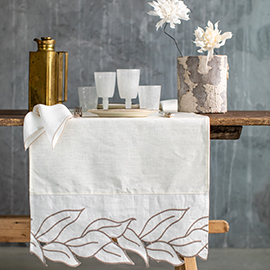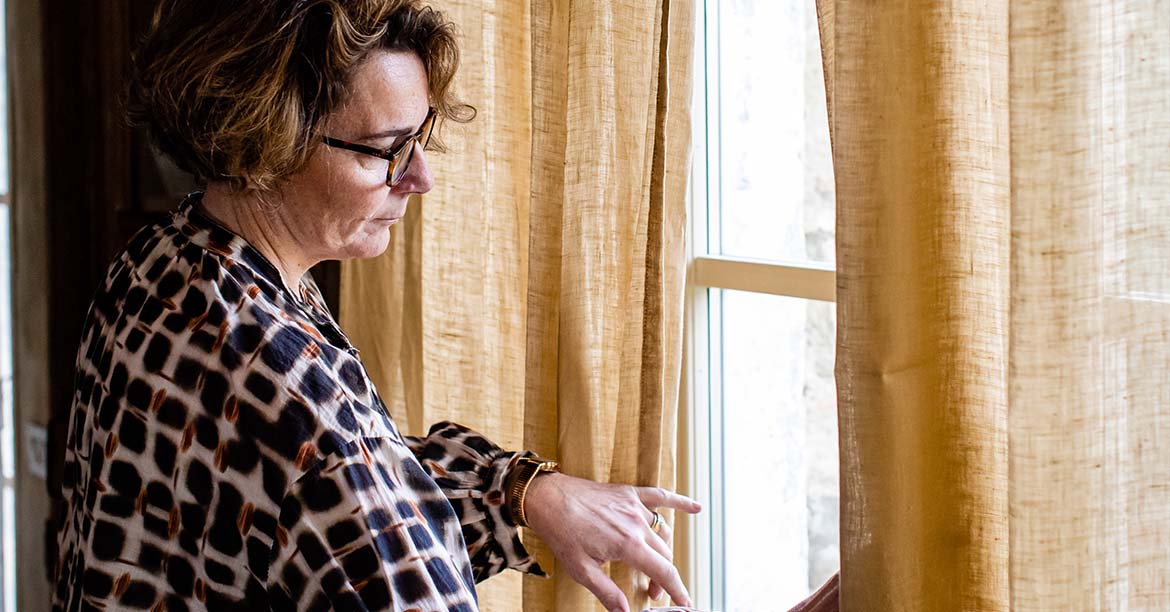
Curtains play a fundamental role in the decoration of your rooms. They are the eyes of our home and, like make-up for the face, can give it a special style. They occupy a considerable amount of space when you let your gaze run over a room and therefore have a strong decorative power: they can lend a touch of romance and softness to a room or instead impart a formal elegance to your surroundings. They also have the power to emphasise the heights of soffitti, the beauty of certain infices, or to minimise the defects of a room, Last but not least, curtains have a very high sound-absorbing capacity, reducing the annoying effect of echoes in some rooms, perhaps too large or furnished in a minimalist style. This is why it is essential to weigh your choice well and not dismiss it with a simple "I'll think about it later": the style of curtain, the size, the position, and of course the fabrics and colours you choose can radically change the look of your decor.
Of course we can make different curtains depending on whether we are in the city, the country, the sea or the mountains! Like clothing, interior design and decoration also has codes that can be adapted to different situations! Curtains also have a shielding or shading function, i.e. they protect rooms from the sun, but also from glances, and are therefore an obligatory choice in certain cases of proximity. If you are not particularly fond of rich curtains or classic furnishings, fear not, there are in fact curtains suitable for every style, even the most minimalist. My advice before making any choice is to get advice from a professional, an interior decorator, an architect or an upholsterer, as well as to get an idea on the subject, which we delve into today in this article in which we look at everything you need to know before buying curtains.
How Are Curtain Measurements Taken?
Before buying a blind, it is good to take the measurements of the window well. There are two measurements to be taken: the height, from the connection to the ground, and the width.
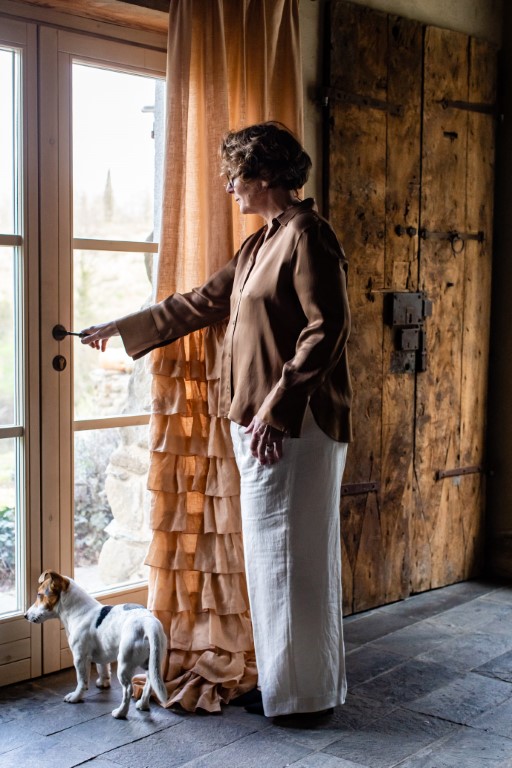 |
 |
 |
How to choose the height of the blinds
We must, of course, have decided whether we are going to attach our blinds with a rod or with a reloga, which must be fitted before we define the height of the blinds. Here we have two cases: If we have a pole with rings, the height will go from the pole to the ground. If we have opted for a relogue, the size of the finished curtain must also necessarily cover the relogue itself. As for the drop of the curtain, there is no fixed rule, it is a matter of personal taste. I like curtains that touch the ground by 5 or 6 centimetres. Many people, however, find them impractical for cleaning and prefer curtains that are raised off the ground. In this case more than ever, measurements will have to be precise, and you will have to be sure that the pole is mounted correctly, parallel to the floor, or that the curtains fit any slopes.
Long curtains or short curtains?
Aesthetically speaking, never choose short curtains, unless you have a floor or a piece of furniture under the finestration that does not allow you to make long curtains. In this case, however, in my taste it is better to opt for a packet or glass curtain. And in the event that there are several windows and French windows in the same room, what is best to do? Granted that, as I said, short curtains are not an option for me, I dress both windows and French doors in the same way where possible. Particularly when they are on the same wall and perhaps next to each other, the aesthetic effect of several identical long curtains placed in such a way as to create a repetition will be particularly elegant. If, on the other hand, you have several windows in the same room, one or more of which is on top of a piece of furniture or a sofa, you can make long curtains and packet curtains, united by their fabric, details and style.
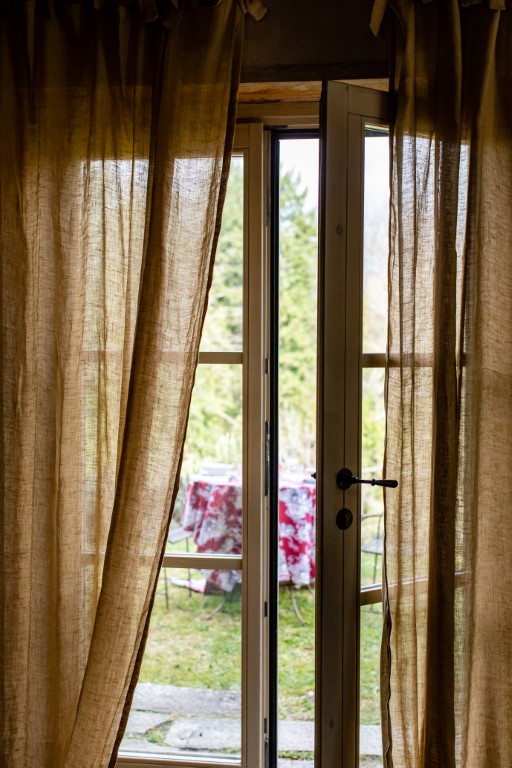 |
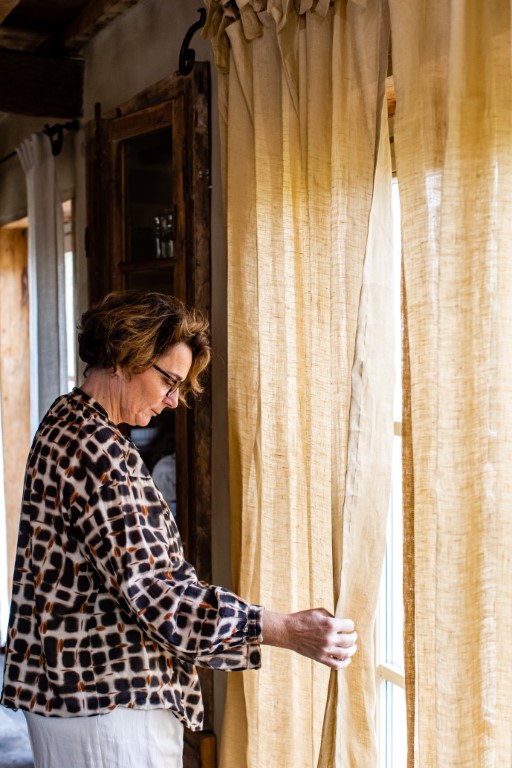 |
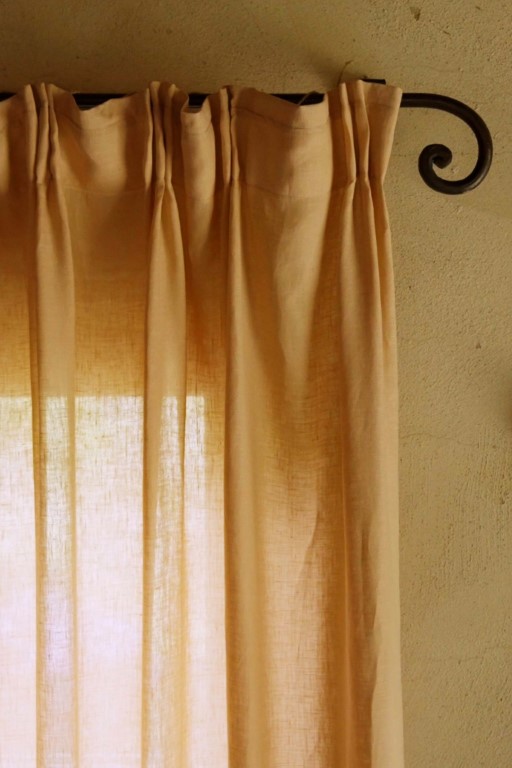 |
How to choose the width of curtains
It is very important to assess the space around the finishings well in order to first understand whether we have sufficient space to gather the curtains and open the finishings comfortably. Furthermore, when establishing measurements, you should try to create or even correct an asymmetry on the walls. If, for example, you have several fintered windows, you should try to balance the spaces at the sides and between the windows, while when a room has asymmetries created precisely by the presence of certain windows or furniture or walls, curtains can minimise the flaws and instead enhance the merits of your room. Once you have taken your measurements well, you must bear in mind that for a 150 cm wide window, for example, you will have to buy two curtains with a width of 140/150 cm. This is because curtains are not like rigid sheets of paper, and on the contrary, they need to be 1.5 to 2 times the width of the window to be beautiful and elegant. They will look soft but, believe me, once they are hung you will never tell they are that big!
One-pane, two-pane or glass blinds?
Depending on the type of windows and the number of sashes we have, the indications for the most suitable type of blind are very different. You can, in principle, consider these: If the firewindow has two sashes, it is best to make a two-panel blind; it simplifies opening and closing; If the window has only one sash, you can opt for a single-panel awning, either to be left straight down or to be picked up on the hinge side of the window. If the window has two sashes but one side is against a wall, then it is better to make a single panel to be collected on the side opposite the wall. Consider carefully whether the window is against a wall or whether it has space on both sides. You must have sufficient space, at least 20 centimetres, to gather the curtain so that you can open the sash.
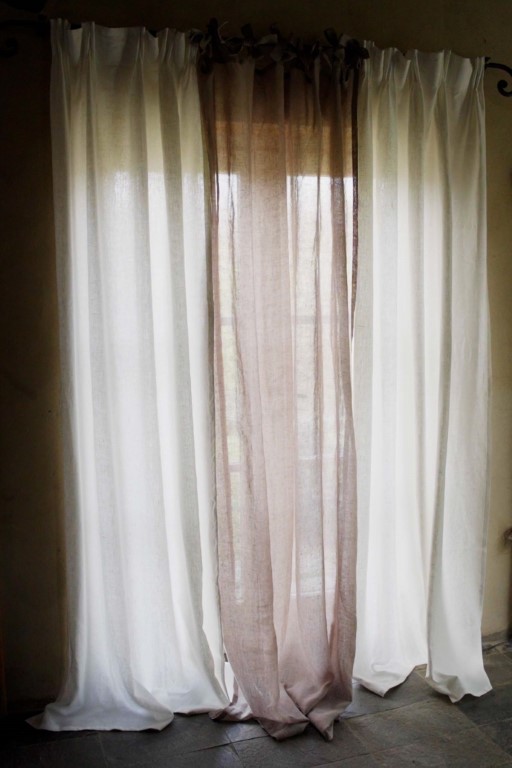 |
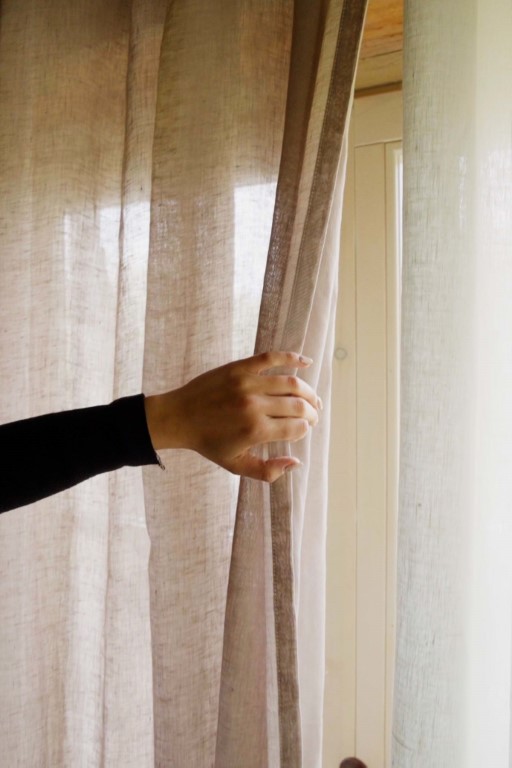 |
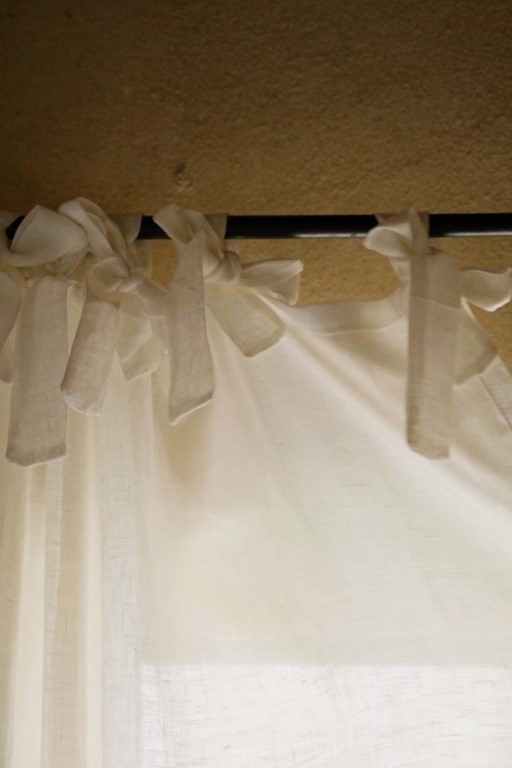 |
Which curtains to choose for kitchen, bedroom, living room
It is also good to distinguish different types of curtains depending on the room in which we wish to place them; for example in the bedroom or the living room we could choose richer and softer curtains, while in the kitchen we could opt for glass curtains, which are more practical. Glass curtains are in fact easy not only to assemble but also to wash, as well as being rather inexpensive, given that the fabric needed to make them is equal to the surface area of the glass: they are therefore perfect for rooms where they would get dirtier. There is much to be said on each subject, making specific distinctions between curtains placed next to or above kitchen worktops and curtains placed in an eat-in kitchen area, i.e. furnished with a dining table or other. Always also consider the risks of having a blind next to worktops. The most insignificant risk is that of soiling and having to wash them frequently, but the far more serious one is the risk of fire if near gas hobs. For these reasons, I tend to recommend packet or glass curtains for windows placed on worktops. This type of blinds can also have different styles, from the more rustic to the more modern and minimalist.
Packet blinds
A separate chapter should be reserved for packet curtains, which are perfect when a piece of furniture or a sofa is placed under the window and far preferable to short curtains. Packet blinds can be attached to a soffitto or wall: if the soffitti are of normal height, between 2.70 and 3 m, I recommend the soffitto attachment. If, on the other hand, they have a higher height, but the windows are much lower, as in the case of many period houses, one can opt for wall-mounted blinds, about 50 to 60 cm above the window. Packet blinds need no less than 25 cm to be drawn above the window, although a distinction must actually be made: Packet blind with a slat at the bottom. It has a slat concealed in a pocket at the bottom and when picked up, it goes up with a straight bottom edge and needs at least 20 cm above the window to be picked up. The slatted awning is also perfectly suited to a modern interior design, creating a shading but absolutely minimal effect, which blends in well with designer interiors. The choice of light and neutral fabrics also enhances your home without taking away light. Italian-style blinds, on the other hand, have a soft bottom, and can be made with 2 or 3 or 5 lowerings, or even more if the wall is very large. The Italian blind is more voluminous and is generally recommended for a more classic furnishing style. However, it can be made with fabrics and materials that make it more modern, such as crumpled linen gauze or metallic gauze. Precise technical knowledge is required to make perfect roman blinds, so we recommend you seek professional advice.
Wall-mounted or ceiling-mounted curtains?
Curtains can be attached to the wall with special rods or tracks, or they can be attached to soffitto. The first thing to assess is the portion of wall available above the window. If you have less than 20 cm, you should opt for a soffitto attachment. Otherwise, opening and closing the window will be difficult, you will risk catching the blind in the sashes, and aesthetically it is better to make the most of the height. The soffitto curtain always emphasises height, and minimises the defect of low soffittos. If a soffitto has beams or vaults, it will be necessary to assess with an upholsterer the best point of anchorage
Synthetic, linen, velvet, silk curtains: which materials to choose for curtains?
The materials to be used for curtains are also very diverse. They range from synthetic fabrics, cotton to linen, velvets to furnishing fabrics with the most innovative and elaborate structures. You must first establish the degree of heaviness you want for your curtains, because a very light fabric such as linen gauze will fit the sun gently, while a heavier linen will create a much stronger effect of shade in the room. It is therefore also important in this case to assess the brightness of a room and not least your lifestyle. If in fact you are a person who only lives in the house in the evening, you will probably choose a furnishing effect rather than a shading function
Blackout curtains
As we said at the beginning, curtains also have the function of screening rooms from the sun. In the bedroom in particular, some people wish to darken rooms completely and therefore require very opaque curtains. If this is the case, there are specialised technical fabrics that can totally block out light. These fabrics are used to double curtains in not too light, transparent fabrics or are used as double curtains.
Double curtains: how to combine fabrics
If you want a more formal effect for your windows, you can opt for double curtains. This involves making two pairs of curtains or two single curtains in different fabrics that will eventually overlap when they close. One of the two fabrics can be totally blackout or, on the contrary, much lighter than the second. I really love the combination of very light linen gauze with linen panama curtains or other heavier furnishing fabrics. The play of colours you can make by combining several curtains of different fabrics will also add a real accent of style to your home. When you have double curtains you tend to leave the lighter ones always pulled together and the heavier ones open, which will mostly be used in the evening to screen the room. In the case of double curtains, on the other hand, one of which is a blackout curtain, these will only be closed for sleeping at night.
Plain or patterned: how to choose colours for curtains
You can opt for plain-coloured curtains from more neutral colours such as white or ivory to pastel colours such as different shades of sand, grey, powder blue pink.
If you have small rooms, it is best to choose light tones, which can make the space seem larger. If the room is large, you can use darker colours without any worries, right down to choosing fabrics with very strong patterns and colours such as stripes, floreal patterns, tropical themes, geometric jacquards, you name it!
I consider curtains as real finishings, which is why in some cases I make elaborate curtains that look more like evening gowns.
As far as brightness is concerned, with brighter rooms you can indulge yourself with darker or brighter colours, while light tones are more suitable for dimly lit rooms.
When choosing colours for curtains, always take into account the style of the furniture, the size of the room, and its exposure to light. In general, you can follow this small guide to curtain colours for the home:
How should curtains be washed?
Like clothes, curtains require special care when washing. In general, follow the manufacturer's or your upholsterer's instructions, but here I can give you some practical tips. Synthetic curtains can be washed in water, often also in the washing machine with special programmes for synthetic fabrics. Linen curtains can certainly be machine washed as long as the fabrics have been soaked before packing. The risk would otherwise be of noticeable shrinkage. Consider that linen shrinks by 10% on the first wash and by another 35 % or so on the second or third wash. If you consider an average length of 300 cm for a curtain, you understand that a shrinkage of 30 cm would be quite a problem! This is why we always advise you to ask for curtains with pre-wet fabrics and to consider, especially in the case of free-falling curtains, an abundance of 5/6 cm for any subsequent shrinkage. In the case of glass or packet curtains, where abundance is not an option, you can keep hems a little higher for safety. I'll also let you in on a little secret... Wet and stretched linen, for example, can recover and stretch even a few centimetres when ironing! Always follow the temperature indications for the different colours, so always cold wash 30 to 40 degrees for coloured curtains. As far as ironing is concerned, it is always advisable to iron your curtains when they are damp: personally, as I also love natural linen, I wash my curtains and simply hang them while still very damp, or I just iron the 4 hems. My linen curtains iron naturally with the force of gravity and at the most if there is a crease left that I don't like, I spray it with a common sprayer and smooth it out with my hands! this allows me to wash them quite often with very little effort! Of course, if you don't feel confident washing your curtains at home, you can always affidirect them to a good launderette who will certainly return them to you clean and perfectly ironed! If, on the other hand, we are talking about furnishing fabrics such as velvets or elaborate jacquards, or even silk...don't hesitate, choose a professional laundry! Let me add just one last consideration. Curtains are not only used to dress windows but can romantically screen a four-poster bed, they can replace wardrobe doors in some particularly suitable situations, or they can conceal and separate specific areas of your home such as basements, closets or doors that you do not want to see. Finally, if they are made appropriately and elegantly, they can also replace a shower stall: they are therefore a truly versatile furnishing accessory that adapts to many of our needs. And if you need custom-made blinds or special designs, you can rely on our custom-made blinds service.
